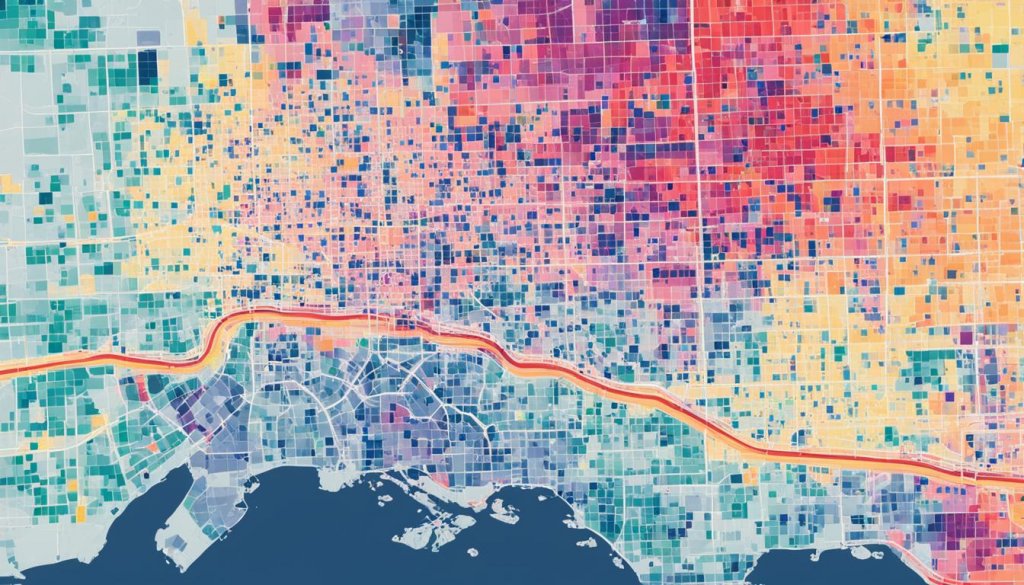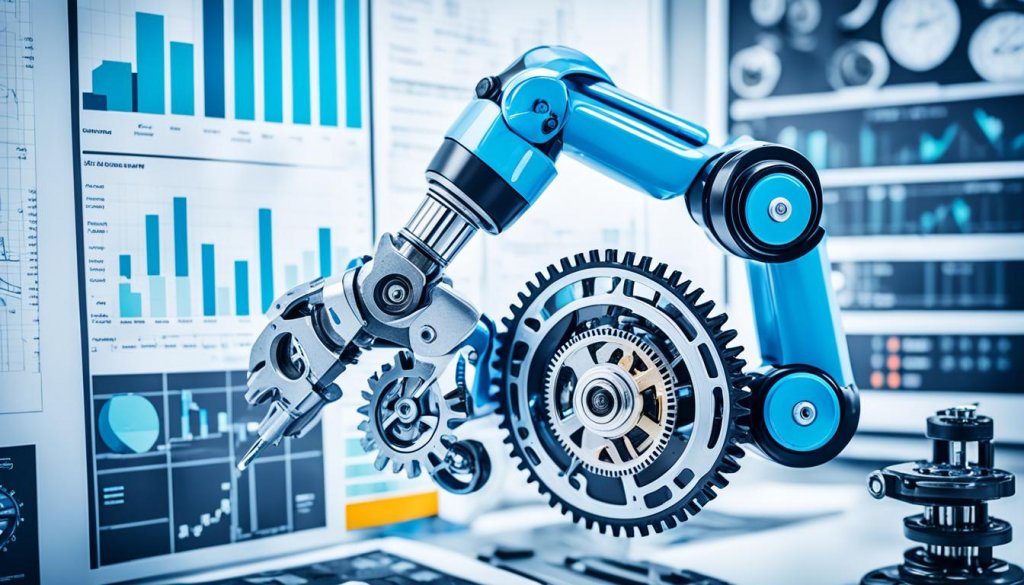Looking at a report, I realized our field service team faced big challenges. We needed to meet customer demands and deal with a lack of skilled workers. The retirement of experienced technicians was making things harder. With 70% of service companies struggling to find enough workers, we knew we had to act fast.
My colleague told me about a company that used AI to improve scheduling. They saw a 30% increase in technician productivity. This made me think about how AI could help us too. By using AI, we could make our operations more efficient and improve customer happiness.
This move to AI wasn’t just about making things run smoother. It showed the big advantages of using AI in managing our workforce. These benefits were something we couldn’t ignore.

Key Takeaways
- The integration of AI in field service is transforming workforce management.
- AI automation can lead to significant efficiency gains in scheduling and operations.
- Addressing talent shortages with AI solutions is critical for organizational success.
- Investing in AI can enhance customer satisfaction through improved service delivery.
- AI technologies streamline routine administrative tasks, freeing up valuable technician time.
- Predictive maintenance capabilities reduce both costs and equipment failures significantly.
The Evolution of AI in Field Service Management
AI has made big strides in workforce planning in field service management over the years. At first, AI automated simple tasks. This let technicians focus on harder tasks. As companies saw the AI impact on human resources, they started using machine learning and predictive analytics to improve operations.
Predictive maintenance is a big step forward. It uses AI to predict when equipment might break down. This helps companies plan maintenance better, cutting down on costs and downtime. AI looks at lots of data to spot patterns that mean a machine might fail soon.
AI sends alerts right away when something goes wrong. This means technicians can fix problems fast, cutting down on downtime. Machine learning uses past data to make good guesses about when maintenance is needed. This helps companies use their resources well. For example, AtriCure uses Microsoft Dynamics 365 Field Service to manage their medical devices better.
The field service industry is always changing, and AI is making things better. AI helps make decisions based on data, not just gut feelings. It makes operations run smoother and helps companies adjust to changes in the workforce and demand for services. This use of AI is leading to better service and happier customers.
The Significance of Predictive Maintenance in Field Service
Predictive maintenance has changed how companies handle their assets in field service. It uses AI to watch over equipment and look at past data to predict when maintenance is needed. This way, companies can fix things before they break down, saving time and money.
The benefits of predictive maintenance go beyond just saving money. Companies like those in manufacturing and energy use it to get better at managing their assets. Predictive analytics can predict when equipment might fail, letting teams plan maintenance early. This cuts down on unexpected problems that could stop work.
Looking closer, AI in predictive maintenance is key to better service operations. It gives insights into equipment patterns and trends. This helps plan better for field workers and use resources wisely across different areas. It makes the workforce more efficient and happy customers.
Switching to predictive maintenance does more than just increase profits by making assets last longer. It also helps with safety and the environment by cutting down on waste. Moving from just fixing things after they break to planning ahead is a big win for field service today.
Understanding the Role of AI in Workforce Optimization
AI is changing how we manage workforces, making it key for today’s strategies. It uses real-time analytics and predictive insights to boost productivity and streamline operations. For example, injixo uses machine learning to predict staffing needs, making adjustments as demand changes.
Looking into AI, I found it automates scheduling and looks at many factors like employee skills and location challenges. This ensures the right people are in the right jobs at the right time, keeping service quality high. AI helps human workers by taking over routine tasks, giving them more time for planning and working together.
When companies use AI, they can change how they manage their workers. AI algorithms make sense of lots of data, helping make decisions that improve employee happiness and involvement. It also finds skill gaps, suggesting training to fill them, which helps optimize the workforce.
Top companies are also using Operations Research to improve workforce planning with AI. While AI makes things more efficient, it’s key to balance AI with human judgment. This balance lets companies use AI fully while keeping creative and social skills that humans have. So, the future of making workforces better looks bright, with AI leading the way in innovation and results.
Benefits of AI in Workforce Management
AI has changed workforce management for the better. It brings many benefits, like making things more efficient and saving money. This leads to smoother operations.
AI helps by automating simple tasks. Now, tasks like documenting work orders are done by AI. This lets field service agents spend more time with customers. This makes customers happier and workers feel more important and productive.
AI can also predict what the future needs will be. It helps with scheduling and using resources well. This means businesses can always be ready for what comes next. Using AI makes teams work better together and keeps everyone connected.
But, using AI also brings challenges. We need to think about ethics and jobs. To solve these issues, we should keep humans in charge and be open about how AI works. This way, workers can feel safe and valued. As we move forward, AI will greatly change how we manage work.
Impact of AI on Workforce Management
AI is changing how we manage work. It automates simple tasks, letting teams focus on what really matters. This shift is seen in many areas, like planning and checking how well people do their jobs.
Enhancing Efficiency Through Automation
AI makes work more efficient. It cuts down the time spent on tasks like planning, tracking time, and deciding where to use resources. For example, AI can review resumes up to 80% faster.
This means companies can do more with less effort. AI also looks at lots of data to make better decisions. This helps in planning the workforce better.
Addressing Labor Shortages with AI Solutions
Many industries face a shortage of workers. AI helps solve this by making workers more effective. It can find 5 million potential workers in just an hour, helping employers find the right talent quickly.
This tech removes the hurdles in hiring, keeping companies flexible. Plus, AI makes workers happier and more likely to stay with the company.
AI Automation in Workforce Planning
AI automation changes how companies manage their teams. It uses real-time data analytics for insights that were hard to get before. This helps businesses predict what they need and plan for employees better.
With AI tools, predicting and adjusting to changes is easier than ever. This makes managing workforces more efficient.
Real-time Data Utilization for Predictive Analytics
Using real-time data analytics helps predict what the workforce needs. Companies now see the value in collecting and analyzing lots of data. AI tools make it easier to use this data for planning and forecasting labor.
This means I can spot staffing issues early and match team skills with project needs. It’s key for keeping services running smoothly and efficiently.
Dynamic Scheduling for Improved Productivity
Dynamic scheduling is a big step forward in making workforces more productive. AI helps match technicians with jobs based on their skills and the situation. This smart planning cuts costs and makes customers happier with quick service.
AI automates scheduling, helping businesses stay on top of market changes.

Building Trust in AI within Field Service
Building trust in AI is key for field service companies to work better. It’s important to use strong AI governance and security steps. Companies should use high-quality data and be clear about how they use AI. Checking how AI systems work helps spot and fix problems.
Being proactive helps workers trust AI more and makes customers trust our services more. Many field service companies, 43%, think AI will make routes better. Also, 39% see AI helping with job priorities soon. This shows how important secure AI systems are.
AI can make customers happier with better online services. By focusing on safety and being open, companies can gain trust in AI. I’ve seen that when jobs are done right the first time, it makes things run smoother.
AI helps with managing inventory and parts, so technicians have what they need. This makes them work better and trust AI more. As we move forward in managing our teams, keeping a strong focus on AI governance and security is key. It helps keep trust and pushes us forward.
The Future of Workforce Management with AI
The future of workforce management with AI looks bright, especially in the field service sector. By using AI, companies could see a productivity boost of 11-15%. This means better work flow and higher profits. AI helps HR folks get real-time data to spot areas that need work and find ways to get better.
AI is key in predicting what the workforce will need in the future. It looks at past data and market trends to make sure there are enough staff. Adding AI to workforce management makes hiring and training smoother. AI-driven onboarding makes training fun, which keeps employees happy and on board.
By 2022, 30% of Tier 1 retailers plan to use smart automation, showing how AI is changing business. AI can spot signs that an employee might leave, helping companies keep their teams stable. Using tech like facial recognition and time clocks rewards employees for hitting their targets.
Most CEOs, 82%, see AI making a big difference in their businesses. As leaders start using AI more, it’s clear that the future of managing workers will blend human smarts with AI tech. To stay ahead, companies need to keep learning and training their teams for this new world.
AI Tools for Workforce Optimization
Exploring AI tools for workforce optimization shows how these technologies change how companies work. They use machine learning to make better decisions, like where to put people and how to use resources well.
Leveraging Machine Learning for Enhanced Decision Making
Machine learning helps businesses spot patterns and trends to improve their work. For example, retailers cut understaffing by 20% during busy times with AI tools. This makes customers happier and helps everyone work better.
AI tools for workforce optimization are powerful, but they need good data to work well. The right data makes these systems more effective and leads to better results.
Integrating IoT and AI for Better Resource Management
Combining IoT with AI changes how we manage resources. This mix gives a deep look at what equipment is doing and how workers are doing. In healthcare, AI helped reduce burnout by 30% through better staff scheduling.
This shows AI tools help make work more efficient and create a better work environment.

Switching to these new systems can be tough, with issues like data privacy and getting people to change. To overcome these, companies should train their staff and manage change well. The future looks like more advanced AI and personalized management, with a focus on ethics to use these tools right.
Using AI and machine learning in managing the workforce makes things run smoother and makes workers happier.
Conclusion
AI is changing how we manage work in the field service sector. Companies using AI can improve maintenance and make their teams work better. This leads to new ways of doing jobs, especially for different groups of people.
It’s key for businesses to get ready for the future with AI in managing their workforce. AI’s growing skills offer new chances in fields like marketing, health, and business analytics. My findings show that many areas will need to change to balance technology with jobs.
The future asks for a workforce that uses AI’s strengths and deals with its challenges. Companies must get ready for this change. They need to see AI’s benefits but also think about the jobs market and how it might change. This includes both new jobs and automation.
See how FieldAx can transform your Field Operations.
Try it today! Book Demo
You are one click away from your customized FieldAx Demo!
FAQ
How is AI transforming workforce management in the field service sector?
AI is changing how we manage work by automating simple tasks. It makes scheduling smarter and helps use resources better. This lets technicians do more important work and makes things run smoother.
What are the benefits of predictive maintenance in field service?
Predictive maintenance helps us know when equipment might break down. This way, we can fix it before it stops working. It cuts down on downtime and costs. Plus, it makes equipment safer and lasts longer.
How does AI contribute to workforce optimization?
AI gives us real-time data and predictions to make better decisions on who does what job. With machine learning, we make sure the right people are on the right tasks. This makes things run more smoothly and improves how we serve customers.
What role does AI play in addressing labor shortages?
AI helps with smart scheduling and assigning tasks. This makes the most of what we have. Even when we’re short on staff, we can keep up with demand without needing more people.
What strategies can organizations use to build trust in AI?
To trust AI, companies should focus on security, quality data, and being open about how they work. Keeping an eye on how AI performs helps fix any issues and build trust with workers and customers.
What does the future of workforce management with AI look like?
The future is bright with AI making things more efficient and improving service quality. Companies that use AI will likely see more productivity and better ways to meet customer needs.
Author Bio
Co-Founder & CMO at Merfantz Technologies Pvt Ltd | Marketing Manager for FieldAx Field Service Software | Salesforce All-Star Ranger and Community Contributor | Salesforce Content Creation for Knowledge Sharing






